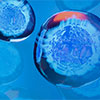BIOTIUM, INC
Supplier:
Biotium
Description:
CD2 interacts through its amino-terminal domain with the extracellular domain of CD58 (also designated CD2 ligand) to mediate cell adhesion. CD2/CD58 binding can enhance antigen-specific T cell activation. CD2 is a transmembrane glycoprotein that is expressed on peripheral blood T lymphocytes, NK cells and thymocytes. CD58 is a heavily glycosylated protein with a broad tissue distribution in hematopoietic and other cells, including endothelium. Interaction between CD2 and its counter receptor LFA3 (CD58) on opposing cells optimizes immune system recognition, thereby facilitating communication between helper T lymphocytes and antigen-presenting cells, as well as between cytolytic effectors and target cells.
CF® dyes are Biotium's next-generation fluorescent dyes. CF®568 is a red fluorescent dye (Ex/Em 562/583 nm) with superior brightness and photostability. It also is compatible with super-resolution imaging by STORM and TIRF.
Supplier:
Biotium
Description:
This MAb recognizes a protein of 134 kDa, which binds fibroblast growth factor and E-selectin (cell-adhesion lectin on endothelial cells mediating the binding of neutrophils). Fucosylation is essential for binding to E-selectin. It contains sialic acid residues and 16 Cys-rich GLG1 repeats. This MAb can be used to stain the Golgi complex in cell or tissue preparations and can be used as a Golgi marker in subcellular fractions. It produces a diffuse staining pattern of the Golgi zone in normal and malignant cells. This MAb is an excellent marker for human cells in xenographic model research. It reacts specifically with human cells. The Golgi apparatus is an organelle present in all eukaryotic cells that forms a part of the endomembrane system. The primary function of the Golgi apparatus is to process and package macromolecules synthesized by the cell for exocytosis or use within the cell. The Golgi is made up of a stack of flattened, membrane-bound sacs known as cisternae, with three functional regions: the cis face, medial region and trans face. Each region consists of various enzymes that selectively modify the macromolecules passing though them, depending on where they are destined to reside. Several spherical vesicles that have budded off of the Golgi are present surrounding the main cisternae. The Golgi tends to be more pronounced and numerous in cells that make and secrete many substances such as plasma B cells.
CF® dyes are Biotium's next-generation fluorescent dyes. CF®594 is a deep red fluorescent dye (Ex/Em 593/614 nm). It yields the brightest conjugates among spectrally similar dyes, and has excellent photostability.
Supplier:
Biotium
Description:
This antibody recognizes a protein of 55 kDa, which is identified as fascin-1. Its actin binding ability is regulated by phosphorylation. Antibody to fascin-1 is a very sensitive marker for Reed-Sternberg cells and variants in nodular sclerosis, mixed cellularity, and lymphocyte depletion Hodgkins disease. It is uniformly negative in lymphoid cells, plasma cells, and myeloid cells. Fascin-1 is also expressed in dendritic cells. This marker may be helpful to distinguish between Hodgkin lymphoma and non-Hodgkin lymphoma in difficult cases. Also, the lack of expression of fascin-1 in the neoplastic follicles in follicular lymphoma may be helpful in distinguishing these lymphomas from reactive follicular hyperplasia in which the number of follicular dendritic cells is normal or increased. Antibody to fascin-1 has been suggested as a prognostic marker in neuroendocrine neoplasms of the lung as well as in ovarian cancer. Fascin-1 expression may be induced by Epstein-Barr virus (EBV) infection of B cells with the possibility that viral induction of fascin in lymphoid or other cell types must also be considered in EBV-positive cases.
CF® dyes are Biotium's next-generation fluorescent dyes. CF®640R is a far-red fluorescent dye (Ex/Em 642/662 nm) with excellent brightness, and the best photostabiity among spectrally-similar dyes.
Supplier:
Biotium
Description:
This antibody recognizes a protein of ~76 kDa, which is identified as Nucleolin (NCL). It is the major nucleolar phosphoprotein of growing eukaryotic cells. NCL is located mainly in dense fibrillar regions of the nucleolus. It is found associated with intranucleolar chromatin and pre-ribosomal particles. Human NCL gene consists of 14 exons with 13 introns and spans approximately 11kb. It induces chromatin decondensation by binding to histone H1. It is thought to play a role in pre-rRNA transcription and ribosome assembly.This MAb can be used to stain the nucleoli in cell or tissue preparations and can be used as a marker of the nucleoli in subcellular fractions. It produces a speckled pattern in the nuclei of cells of normal and malignant cells and may be used to stain the nucleoli of cells in fixed or frozen tissue sections. It can be used with paraformaldehyde fixed frozen tissue or cell preparations and formalin fixed, paraffin-embedded tissue sections.
CF® dyes are Biotium's next-generation fluorescent dyes. CF®405S is a blue fluorescent dye (Ex/Em 404/431 nm) with superior brightness compared to other blue dyes; it is also compatible with super-resolution imaging by SIM. Note: Conjugates of blue fluorescent dyes are not recommended for detecting low abundance targets, because blue dyes have lower fluorescence and can give higher non-specific background than other dye colors.
Supplier:
Biotium
Description:
This antibody recognizes a transcription factor of 64-67 kDa, identified as c-myc. Its epitope spans aa 410-419 (EQKLISEEDL), which is a specific portion of an alpha helical region of human c-myc protein. This MAb shows no cross-reaction with v-myc. c-myc is involved in the control of cell proliferation and differentiation and is amplified and/or overexpressed in a variety of tumors. Overexpression of c-myc protein occurs frequently in luminal cells of prostate intraepithelial neoplasia as well as in most primary carcinomas and metastatic disease.
CF® dyes are Biotium's next-generation fluorescent dyes. CF®555 is a bright orange-red fluorescent dye (Ex/Em 555/565 nm) that is compatible with super-resolution imaging by STORM.
Supplier:
Biotium
Description:
HSP27, Monoclonal antibody, Clone: G3.1, Host: Mouse, Species reactivity: Mouse, Chimpanzee, Monkey, Sheep, Rat, Human, Chicken, Isotype: IgG2a, kappa, Conjugate: CF640R, Immunogen: Partially purified hsp27 (earlier called 24K) protein from breast cancer MCF-7 cells, Size: 100uL
Supplier:
Biotium
Description:
SUMO-2, Monoclonal antibody, Clone: SUMO2/1199, Host: Mouse, Species reactivity: Human, Rat, Isotype: IgG1, Conjugate: CF647, Immunogen: Recombinant human SUMO2 protein, Application: Immunofluorescence, Immunohistology (formalin), Flow cytometry, Size: 100uL
Supplier:
Biotium
Description:
Alkaline Phosphatase Monoclonal antibody, Clone: V17.1, Host: Mouse, Species reactivity: Human, Cow, Isotype: IgG1, kappa, Conjugate: CF594, Immunogen: Bovine intestinal alkaline phosphatase, Size: 500 uL
Supplier:
Biotium
Description:
Actin is a major component of the cytoskeleton and is present in most cell types. It is highly specific to actin from smooth muscles. This MAb does not stain cardiac or skeletal muscle; however, it does stain myofibroblasts and myoepithelial cells. This antibody could be used together with anti-muscle specific actin and myogenin in making a diagnosis of smooth muscle and skeletal muscle tumors. In most cases of rhabdomyosarcoma, this antibody yields negative results whereas anti-muscle specific actin and myogenin are positive. Leiomyosarcomas are positive only with anti-muscle specific actin and anti-smooth muscle actin and are negative with anti-myogenin.
CF® dyes are Biotium's next-generation fluorescent dyes. CF®405S is a blue fluorescent dye (Ex/Em 404/431 nm) with superior brightness compared to other blue dyes; it is also compatible with super-resolution imaging by SIM. Note: Conjugates of blue fluorescent dyes are not recommended for detecting low abundance targets, because blue dyes have lower fluorescence and can give higher non-specific background than other dye colors.
Supplier:
Biotium
Description:
with CF660C. CF660C can still be sufficiently excited by the 633/635 nm laser with emission at 685 nm. CF660C is several fold brighter and significantly more photostable than Alexa Fluor 660.
Supplier:
Biotium
Description:
CD11A Monoclonal antibody, Clone: Cris-3, Host: Mouse, Conjugate: CF405S, Species reactivity: Human, Immunogen: Recombinant human CD11b protein, Isotype: IgG1, kappa, Application: Flow Cytometry, Size: 100uL
Supplier:
Biotium
Description:
This antibody recognizes a protein of 110 kDa, which is identified as androgen receptor (AR). It reacts with full length, and the newly described A form of the receptor. It does not cross react with estrogen, progesterone, or glucocorticoid receptors. The expression of AR is reportedly inversely correlated with histologic grade i.e. well differentiated prostate tumors show higher expression than the poorly differentiated tumors. In prostate cancer, AR has been proposed, as a marker of hormone-responsiveness and thus it may be useful in identifying patients likely to benefit from anti-androgen therapy. Anti-androgen receptor has been useful clinically in differentiating morpheaform basal cell carcinoma (mBCC) from desmoplastic trichoepithelioma (DTE) in the skin.This MAb is superb for staining of formalin/paraffin tissues.
Supplier:
Biotium
Description:
CF® dye labeled dextrans could be used as a fluorescent fluid-phase markers to study cell permeability, endocytosis, or mechanisms of biomolecular delivery. The dextran is 10,000 MW, and contains a formaldehyde-fixable free-amine group.
Supplier:
Biotium
Description:
This antibody recognizes a protein of 150 kDa, which is identified as the high molecular weight variant of Caldesmon. Two closely related variants of human caldesmon have been identified which are different in their electrophoretic mobility and cellular distribution. The h-caldesmon variant (120-150 kDa) is predominantly expressed in smooth muscle whereas l-caldesmon (70-80 kDa) is found in non- muscle tissue and cells. Neither of the two variants has been detected in skeletal muscle. This MAb This antibody recognizes only the 150 kDa variant (h-caldesmon) in Western blots of human aortic media extracts and is unreactive with fibroblast extracts from cultivated human foreskin. Caldesmon is a developmentally regulated protein involved in smooth muscle and non-muscle contraction.
Catalog Number:
(10001-922)
Supplier:
Biotium
Description:
Llama anti-rabbit CF™ dye conjugates are prepared by labeling affinity purified llama anti-rabbit IgG (H+L) with a selection of CF™ dyes. CF™ dyes offer combined advantages in brightness, photostability, and specificity compared other fluorescent dyes. CF™640R (Ex/Em 642/662 nm) is a novel far-red rhodamine-based dye spectrally similar to Cy®5 and Alexa Fluor® 647. CF™640R is much brighter than Cy®5 and at least as bright as Alexa Fluor® 647 when excited at 633 or 635 nm. However, the most important advantage of CF™640R is its exceptional photostability.
Alexa Fluor® is a registered trademark of Thermo Fisher Scientific. Cy®5 is a registered trademark of GE Healthcare.
Supplier:
Biotium
Description:
This antibody neutralizes TNF alpha biological activities. It prevents TNF alpha induced apoptosis in Jurkat cells. It also neutralizes HurTNFamediated cytotoxicity of L929 cells and inhibits tumor growth in mice. It protects mice against toxicity of HurTNFa. Tumor Necrosis Factor Alpha (TNF alpha) is a protein secreted by lipopolysaccharide-stimulated macrophages, and causes tumor necrosis when injected into tumor bearing mice. TNF alpha is believed to mediate pathogenic shock and tissue injury associated with endotoxemia. TNF alpha exists as a multimer of two, three, or five non-covalently linked units, but shows a single 17 kDa band following SDS PAGE under non-reducing conditions. TNF alpha is closely related to the 25 kDa protein Tumor Necrosis Factor beta (lymphotoxin), sharing the same receptors and cellular actions. TNF alpha causes cytolysis of certain transformed cells, being synergistic with interferon gamma in its cytotoxicity. Although it has little effect on many cultured normal human cells, TNF alpha appears to be directly toxic to vascular endothelial cells. Other actions of TNF alpha include stimulating growth of human fibroblasts and other cell lines, activating polymorphonuclear neutrophils and osteoclasts, and induction of interleukin 1, prostaglandin E2 and collagenase production.
CF® dyes are Biotium's next-generation fluorescent dyes. CF®594 is a deep red fluorescent dye (Ex/Em 593/614 nm). It yields the brightest conjugates among spectrally similar dyes, and has excellent photostability.
Inquire for Price
Stock for this item is limited, but may be available in a warehouse close to you. Please make sure that you are logged in to the site so that available stock can be displayed. If the
Stock for this item is limited, but may be available in a warehouse close to you. Please make sure that you are logged in to the site so that available stock can be displayed. If the
You must log in to order restricted items. We request that you provide the required business documentation to purchase this product for the first time.
To order chemicals, medical devices, or other restricted products please provide identification that includes your business name and shipping address via email CMD_NA@vwr.com or fax 484.881.5997 referencing your VWR account number . Acceptable forms of identification are:
-Additional Documentation May be needed to purchase this item. A VWR representative will contact you if needed.
This product has been blocked by your organization. Please contact your purchasing department for more information.
The original product is no longer available. The replacement shown is available.
This product is currently unavailable but limited stock may be available in our extended warehouse network. Please call 1-800-932-5000 and a VWR Customer Service Representative will help you.
|
|||||||||


































